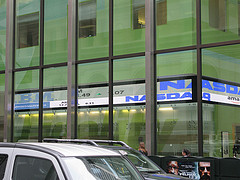Whenever I have a conversation about the environmental and social injustices around the country and the world, it follows a similar pattern: Look at Place X, Y or Z, it’s really messed up. Their natural resources (insert precious metal, timber, or fossil fuel) are being exploited by outside interests or corporations, enabled by a corrupt/complicit local government, leaving behind an impoverished local population in a polluted/toxic/barren environment. Check out at this picture/article/report/book, it’s really messed up.
The conversation then turns to this question: “What can we do?”
There might be some good suggestions. Donate to Organization X, Y, or Z, they do great work on this issue! Write a letter to the editor or a blog post to shine a light on the situation. If it’s an activist group, you might perhaps plan a trip to the sight of the injustice or plan a protest at the main benefactor’s headquarters.
Ultimately though, there’s always that one moment of shared exasperation that sounds something like this: Money talks, and the system is rigged in favor of the few corporations who own and control most of it. At the expense of people and the planet.






Money begets more money. It’s how capitalism works. If you have enough of it you can make more rather handily. Whether it’s in a savings account or invested in stocks or mutual funds, once you have money that you don’t need immediately you can just sit back and watch it grow.
If you don’t have more than you need to survive, life is much harder. You have to work for every penny, and if you fall behind in any of your payments, you fall into debt. While the person with the savings and investments spirals upwards quite automatically in this system, the person with debt is usually spending all his/her energy and resources trying to avoid spiraling downwards.
As to which side of this invisible divide you fall depends on many factors. Some are born into money, others worked hard to get ahead. Some are born into poverty, others caught a few bad breaks. Race, gender, social status, geography, history, it’s usually many layers. The most poetic view from the downside I’ve ever heard were in the lyrics of my favorite German anarchist punk band, Strassenjungs: (translation mine)
It’s always the same
It’s always the same
It’s a vicious cycle
It’s always the same
you’re turning into a zombie and the cycle remainsYou come into this world whether you like it or not
and you quickly realize what you need here is money
Some have a lot, the devil knows how they got it
but you’ve got to slave away for it and you think:
That’s not fair!
The great money divide works in the same way for institutions, corporations and countries. Once you fall behind, it’s really hard to get back up, whether you’re in Haiti, Madagascar, or The Sudan. Once your resources have been drained and your land has been ravaged it’s hard to get healthy again. See the Democratic Republic of Congo, the Niger Delta, Ecuador, or closer to home, Appalachia. Once the dynamics of capitalism are set into place, there are winners and losers, often so far apart from each other that the mechanisms behind the divide are invisible and the circumstances seem random.








Of course, money in itself is not bad, it’s really just a means by which we’ve ascribed value to the things we need to survive in a post-hunter and gatherer era. It’s just that the way our monetary system has been set up, rather than being spread around with a fair chance for everyone to at least gain access to the security and basic needs it affords, there seems to be a slight tilt on the playing field that makes all the money ultimately flow in one direction: Toward big banks.
Credit cards are a good example to illustrate how even when we think we’re putting money toward leveling that playing field it really just keeps sliding off the table and into a few big gourds. While it’s certainly a noble intention to get the latest Sierra Club or Nature Conservancy card, it’s important to remember that these cards are ultimately run through just a handful of credit card issuers, with Visa and MasterCard together holding about 70 percent of the credit card market. But it gets really interesting when you see who is actually lending you the money to support your favorite environmental cause:
Although credit cards bear the logo of Visa, MasterCard, or one of the other networks, they are actually issued by banks. The leading U.S. bank credit card issuers are Bank of America, J.P. Morgan Chase, Citigroup, Capital One, and HSBC Bank.
That’s right, the same players that came out victorious from the bailout slugfest ultimately profit from almost every transaction in the US of Credit Card. These same financial institutions that profit the most from environmental degradation rooted in a system based on the bottom line get a fat cut every time we swipe our pretty ___insert environmental organization___ cards. It’s like washing down your locally grown organic apple with a 32oz Coke.
And they’re not just obscure behind-the-scenes institutions anymore but posing as the friendly next door neighbor. Even in my progressive town, between the natural remedy store and the fair trade cafe, the ominous blue signs are popping up everywhere.








The Big Question: What to do?
Believe it or not, the situation is actually not as hopeless as it sounds. More often than not, good alternatives are available if only we do a little research and are willing to get off the beaten track a bit. It’s not like the big banks are holding a gun to our head, telling us to buy and borrow from them. They just want to make themselves the path of least resistance, to the point where we don’t even think there could be other ways, which they’ve been very successful at.
It’s like breaking a nasty habit at the grocery store: It takes some effort, planning and presence to intercept the cashier before he can put that stick of butter in a plastic bag. However, once you’ve weaned yourself off autopilot (preempting the cashier with the canvas bag you remembered to bring) you’ll find that life can be perfectly functional and fulfilling without all those petroleum-sucking garbage patch producers. And if more people start doing it, the cashier will stop assuming that everybody needs a plastic bag. Voila, vicious cycle broken.
So here are a few tips on how to break the vicious banking cycle, reduce the “collateral damage” of the money we spend, and perhaps level the playing field a bit more in the bigger picture. It’s by no means a complete list but a starting point for those who wish to jump off the great big polluting carousel:
1) Credit Cards
If you’re looking for a credit card that is not issued by one of the big lenders, check out the Salmon Nation card. It is issued by ShoreBank Pacific, a Washington State chartered, FDIC insured bank, the first commercial bank in the United States with a commitment to environmentally sustainable community development. Ditto the new Green America card. (One caveat: Shorebank Pacific to this day has been unable/unwilling to eliminate paper bills, which I’ve found to be seriously annoying). You may also find a credit card issued by your local credit union that keeps your money more local and your debt less likely to contribute to other people’s misery. If you’re fortunate enough to not have to go into debt at all, paying off your regular card in time keeps the big boys from getting bigger. Check out more responsible credit cards and see which of the megabanks are donating to coal-fired power plants here.
2) Socially Responsible Investing (SRI)
Recently the Social Investment Forum (SIF) released a new Report stating: “Two Thirds of Socially Responsible Mutual Funds Outperformed Benchmarks During 2009 Economic Downturn.” If you happen to find yourself in the position to be able to invest money, good for you. You can make it good for others as well by putting your money into funds that reflect your values. A word of caution though: A lot of these funds vary greatly in their actual commitment to environmentally and socially engaged companies, some of them only cut out the very worst of the polluters. Two of the funds with pretty decent track records are Portfolio 21 and Green Century.
3) Rethinking Money
Ultimately, we’ll have to rethink the way we trade goods and build nest eggs if we are to make it through climate change and peak oil and live in ecological balance with our planet. Some initiatives launched in the last year are gaining momentum around the country. The Slow Money movement looks at investment strategies revolving mostly around the world of local food and farming. The Move Your Money campaign was launched to help individuals and companies move their finances into local community banks and credit unions. The Common Good Bank is a new banking model where depositors decide what the bank should invest in. And a whole range of community currencies, barter and local exchange trading systems have sprung up around the world addressing the collective desire for more fair and just transactions based on direct interactions and actual value rather than speculation and quarterly earnings.
The question is, who are we going to listen to on our way forward?
The corporate marketeers? ……………………. or our highest ideals?


==============
Niger Delta photos by Ed Kashi
Resources:
Responsible Credit Cards
Social Investment Forum
Slow Money movement
Move Your Money
Common Good Bank
Green Money Journal








I am absolutely fascinated by point #3, especially community currencies. I first saw this in action in the Berkshires in Massachusetts, where the currency is cleverly called the BerkShares. I had no idea that it had become such a movement.
Thanks, as always, Sven, for your deep insights into these tough issues. (And great use of photos to move us all along with you!)
Barbara
Yes, it’s a really cool idea. I think money has intentionally become so complex so that the people who create all the additional layers and language can profit off of everyone else’s confusion and apathy. The community currencies bring us back to the true spirit of money, and it’s easy to understand without taking a finance class. Thanks for checking in, Barb.
Wow, you spent a lot of hours on this piece, Sven. Wish you wrote these in-depth, insightful articles for the New York Times, or LA’s big paper–even San Francisco’s biggest paper. Thanks for taking an even broader view of very complicated issues and helping us to understand more and what great links you gave us. Thanks! Pam
Thanks for reading, Pam. I’m definitely available for assignment by any of the papers you mention :-). I’m certainly honored that you would think me to be qualified. I’ll just keep putting my best foot forward and leave the rest up to the stars…
Thank you for both your insightful observations AND practical suggestions! Both offer plenty to think about and act on. Much appreciated!
[…] I’d done some research a while ago on banking and financial alternatives for a post entitled One Man’s Portfolio is Another Man’s Oil Spill, and so I started to study up on which of the many great alternatives out there would be the right […]